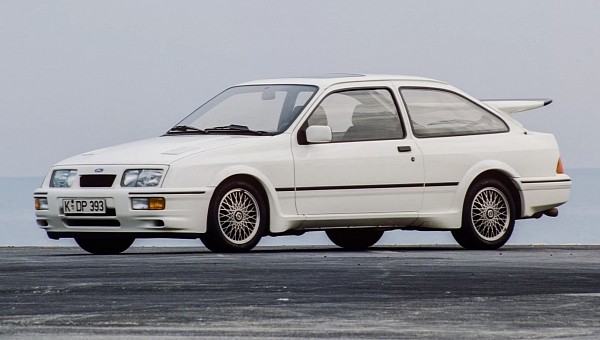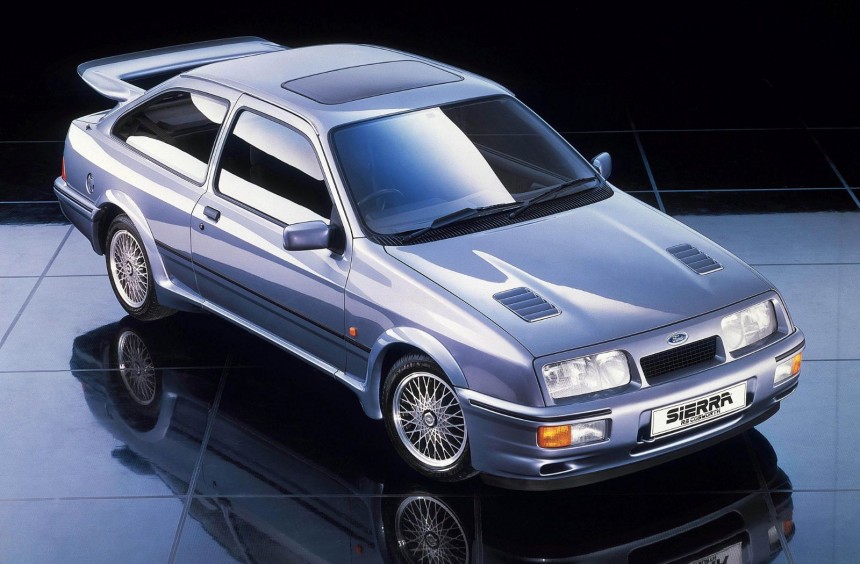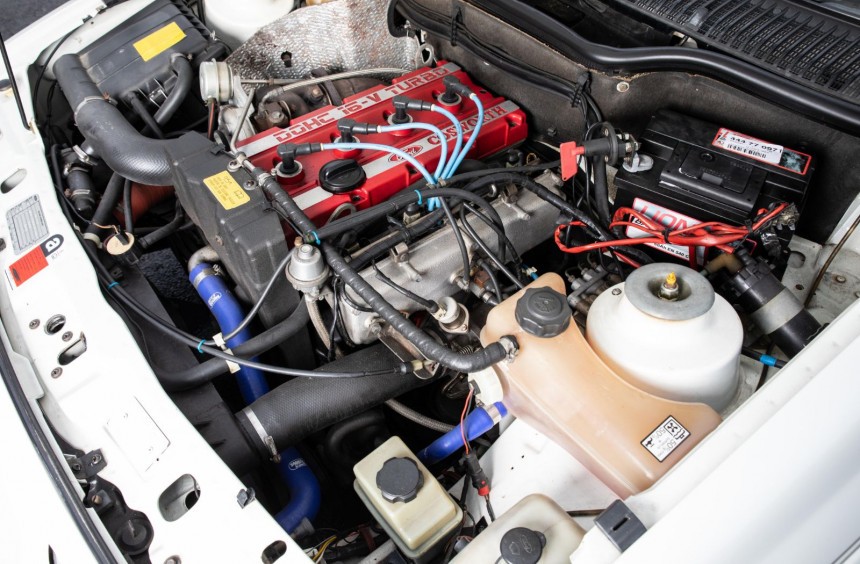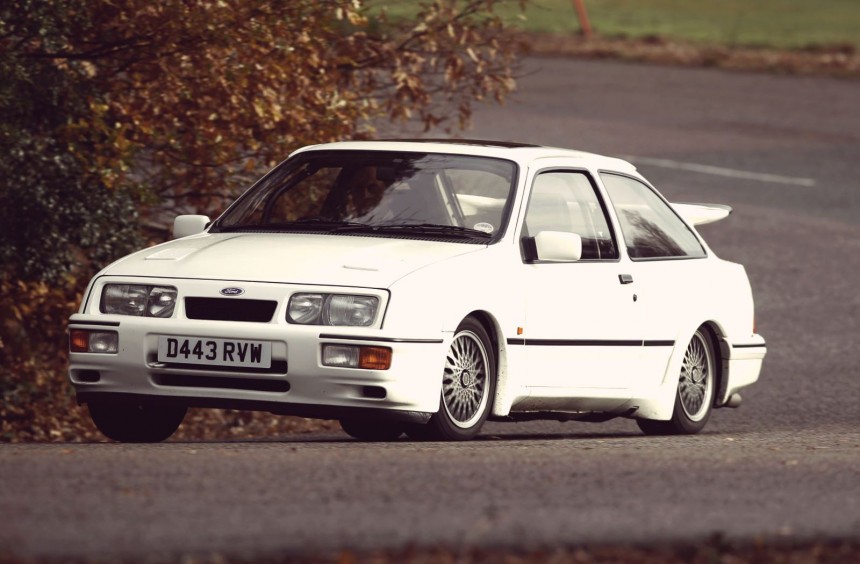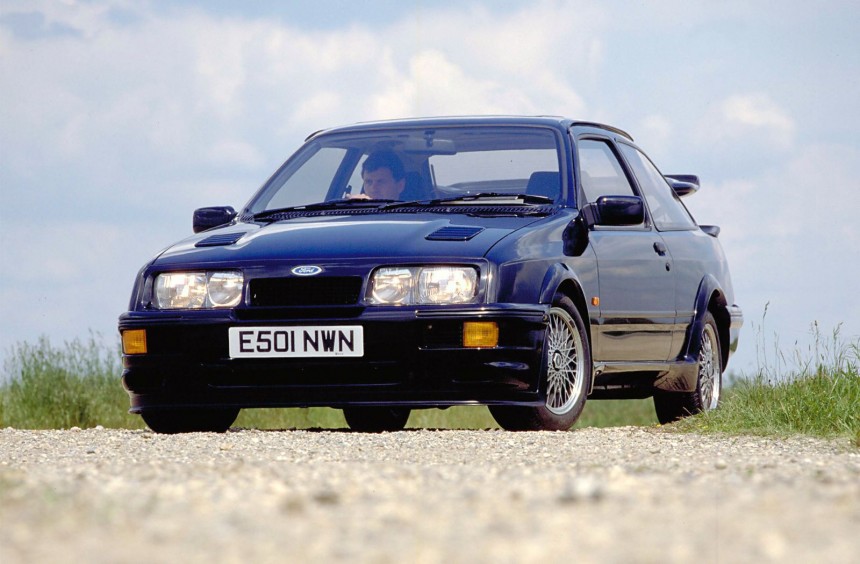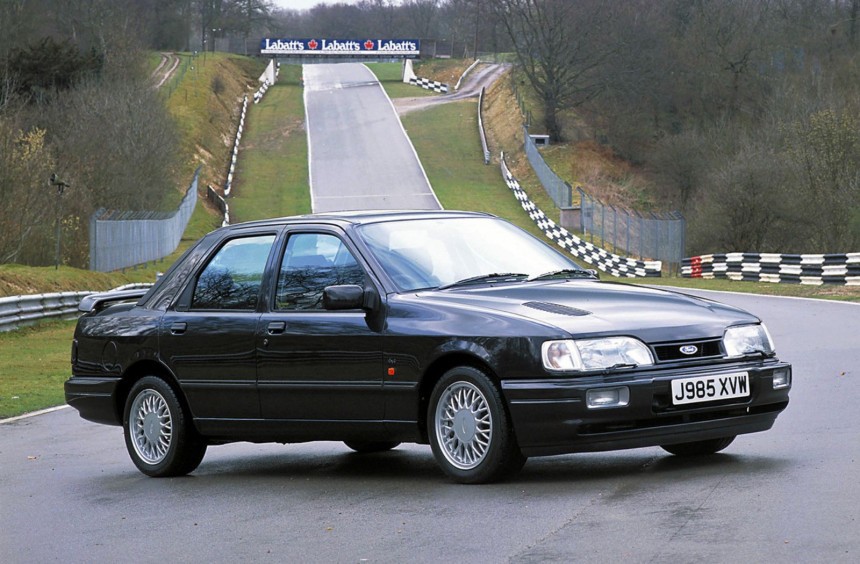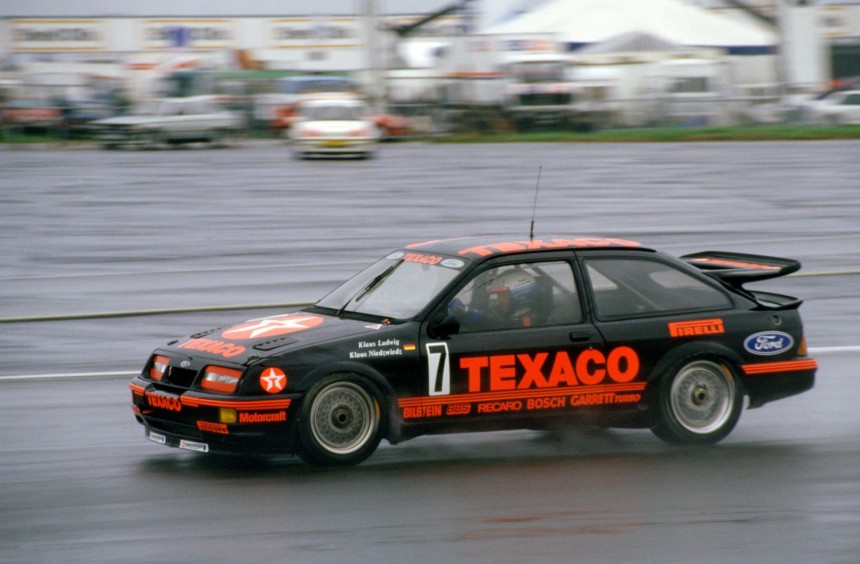From 1986 to 1992, Ford’s European branch manufactured a high-performance version of an otherwise boring model, which became a timeless icon both on public roads and on the world’s most illustrious race tracks.
More than a century ago, Ford brought the notion of mass production to the world of automobiles with its innovative assembly lines and revolutionized the industry.
Although the Detroit carmaker would soon go global over the next decades, its most impressive models were still being developed back home, in the U.S. The horsepower wars of the 1950s and 1960s as well as Henry Ford II’s ambition to beat Ferrari at Le Mans gave birth to icons such as the Mustang, Torino, and GT40.
But, during the 1980s, the corporation’s European subsidiary embarked on a project that resulted in one of the most impressive Ford-badged models ever created on the Old Continent: the Sierra RS Cosworth.
With the advancements in motorsport, several European manufacturers were starting to develop high-performance cars to homologate mass-produced models for racing.
Ford had been dominating several motorsport categories during the 1970s, but despite this, it lacked a true homologation special. Thus, in 1983, Stuart Turner, the subsidiary’s newly-appointed boss and lifelong motorsport enthusiast decided to change this.
In the months that followed, he put together a team that included vice-president of public relations Walter Hayes, who had been involved in the development of the GT40 race car and the Cosworth DPV Formula 1 engine.
They settled on the mid-size Sierra as the ideal platform for the project, but to transform it into a vehicle that could be both appealing to enthusiasts in road legal form and capable of winning titles as a full-blown race car, it needed a state-of-the-art engine.
Back then, if Ford Europe needed a good engine, they turned to long-time partners Cosworth who were responsible for the aforementioned DPV, the unit that gave Ford 12 Formula 1 titles and 154 grand prix victories during the 1960s and 1970s. Therefore, Turner and Hayes visited the Cosworth headquarters where they were introduced to a skunkworks project that just happened to be exactly what they were looking for.
Initially codenamed YAA and designed by Mario Illien, the engine in question was a 2.0-liter, four-cylinder based on the block of the old T88-series “Pinto”, but it featured a Cosworth-designed aluminum block with overhead cams and four valves per cylinder.
The Ford officials asked Cosworth to build them a turbocharged version of this unit that could produce 180 hp (182 ps) in street guise and up to 300 hp (304 ps) in race trim. The engineering wizards agreed, but knowing what their rabid little powerplant could do, they asked Ford to accept a street version that could make no less than 204 hp (207 ps) and forced them to sign an agreement for a 15,000-unit production run.
Despite only needing 5,000 units to homologate the car, Ford accepted and the turbocharged YB that subsequently went into production became one of its best, most tunable European engines ever.
Based on the three-door hatchback Sierra which was deemed the most aerodynamically efficient, the RS Cosworth was designed by Lothar Pinske. I received numerous aesthetic improvements over the dull mass-produced version, including wider wheel arches, a large opening in the front grille, and a humongous rear spoiler that improved stability at high speeds.
The team gained valuable input from Jack Roush who raced a modified version of the Merkur XR4Ti (the re-badged, North American Sierra) in the United States. Roush innovations influenced many modifications that made the RS Cosworth special, including its suspension system and chassis stiffening.
Available in only three color choices: black, white, and moonstone blue, the RS made its debut at the 1985 Geneva Motor Show, going into production about a year later. Although Walter Hayes had trouble convincing European Ford dealers that it would be a terrific product, the car proved to be a hit among enthusiasts, allowing the company to sell more than 5,000 units in less than a year.
With its 204-hp (207-ps) turbocharged four, the RS could sprint to 60 mph (97 kph) from a standstill in 6.5 seconds and reach a top speed of 149 mph (240 kph). This was by no means mind-blowing, but the car quickly became a fan favorite for its impeccable handling that, combined with the adequate power of its Cosworth unit, made it feel like a true sports car.
While the standard RS Cosworth was extremely good, the 1987 RS500 was even better. Built using the chassis of the initial RS, it was created to gain Group A homologation. As the name implies, it was produced in only 500 units, all of which were hand-assembled by Aston Martin Tickford and were sold only in the UK.
Apart from minor visual modifications, the main upgrade over the original model was a competition-spec variant of the Cosworth engine. Limited to 224 hp (227 ps) in the road-legal cars, but capable of nearly twice as much in race-spec, the motor was built around a thicker block and featured many improvements like a bigger Garrett T04 turbo, an air-to-air intercooler, a performance fuel pump, or reworked oil and cooling systems.
The RS500 would go on to earn the Blue Oval multiple touring car titles and today, it is considered by many enthusiasts to be the best car ever produced by Ford in Europe. It’s also the most sought-after, with examples in great condition being auctioned off for well over $500,000.
With the original RS hatchback and the legendary RS500, Ford managed to build a little over the 5,000 units they initially planned. But, as I mentioned before, to get hold of the brilliant Cosworth YB, the company was forced to agree to buy 15,000 engines.
To sell the remaining motors, Ford launched a second production run of the Cosworth-powered Sierra, but to make it appealing to a wider range of buyers, the facelifted four-door sedan chassis was chosen.
Called Sierra Sapphire RS Cosworth in the UK, it was equipped with the same YBB engine as the original RS but lacked the multitude of exterior enhancements. Nevertheless, it proved a winning formula as Ford sold over 13,000 examples from 1988 to 1990.
The third and last iteration of the Cossie came in 1990. Also a four-door sedan boasting the latest facelift, it featured a new Ferguson MT75 five-speed transmission and a four-wheel-drive system. Moreover, the Cosworth engine was improved, and it could now produce 220 hp (223 ps).
By the early 1990s, the street versions of the RS Cosworth were the most popular high-performance cars that Ford had produced in Europe, but this could not have been possible without the model’s motorsport achievements.
The RS500 made its debut in the fall of 1987 and competed in that year’s six remaining World Touring Car Championship (WTCC) races, winning four of them, which translated into the manufacturer’s title for the Eggenberger Motorsport works team.
In 1988, the RS500 became the most successful race car of the year, winning the Deutsche Tourenwagen Meisterschaft (DTM), the Australian Touring Car Championship, and the Japanese Touring Car Championship. With the exception of the DTM, it won those competitions again in 1990, adding a host of other triumphs to its name, including titles in the British Touring Car Championship and the Australian Endurance Championship.
Although it wasn’t the prettiest, nor the most powerful high-performance model to don Ford badges, the Sierra RS Cosworth was unquestionably one of its greatest. It paved the way for the company’s lineage of RS-badged icons and three decades after the last one rolled off the assembly line, it continues to fascinate enthusiasts all over the world. You can see why in the YouTube video below posted by Mk1Kieran.
Although the Detroit carmaker would soon go global over the next decades, its most impressive models were still being developed back home, in the U.S. The horsepower wars of the 1950s and 1960s as well as Henry Ford II’s ambition to beat Ferrari at Le Mans gave birth to icons such as the Mustang, Torino, and GT40.
But, during the 1980s, the corporation’s European subsidiary embarked on a project that resulted in one of the most impressive Ford-badged models ever created on the Old Continent: the Sierra RS Cosworth.
How it all started
Ford had been dominating several motorsport categories during the 1970s, but despite this, it lacked a true homologation special. Thus, in 1983, Stuart Turner, the subsidiary’s newly-appointed boss and lifelong motorsport enthusiast decided to change this.
In the months that followed, he put together a team that included vice-president of public relations Walter Hayes, who had been involved in the development of the GT40 race car and the Cosworth DPV Formula 1 engine.
They settled on the mid-size Sierra as the ideal platform for the project, but to transform it into a vehicle that could be both appealing to enthusiasts in road legal form and capable of winning titles as a full-blown race car, it needed a state-of-the-art engine.
The small but mighty Cosworth YB
Initially codenamed YAA and designed by Mario Illien, the engine in question was a 2.0-liter, four-cylinder based on the block of the old T88-series “Pinto”, but it featured a Cosworth-designed aluminum block with overhead cams and four valves per cylinder.
The Ford officials asked Cosworth to build them a turbocharged version of this unit that could produce 180 hp (182 ps) in street guise and up to 300 hp (304 ps) in race trim. The engineering wizards agreed, but knowing what their rabid little powerplant could do, they asked Ford to accept a street version that could make no less than 204 hp (207 ps) and forced them to sign an agreement for a 15,000-unit production run.
Despite only needing 5,000 units to homologate the car, Ford accepted and the turbocharged YB that subsequently went into production became one of its best, most tunable European engines ever.
The first-generation hatchback
The team gained valuable input from Jack Roush who raced a modified version of the Merkur XR4Ti (the re-badged, North American Sierra) in the United States. Roush innovations influenced many modifications that made the RS Cosworth special, including its suspension system and chassis stiffening.
Available in only three color choices: black, white, and moonstone blue, the RS made its debut at the 1985 Geneva Motor Show, going into production about a year later. Although Walter Hayes had trouble convincing European Ford dealers that it would be a terrific product, the car proved to be a hit among enthusiasts, allowing the company to sell more than 5,000 units in less than a year.
With its 204-hp (207-ps) turbocharged four, the RS could sprint to 60 mph (97 kph) from a standstill in 6.5 seconds and reach a top speed of 149 mph (240 kph). This was by no means mind-blowing, but the car quickly became a fan favorite for its impeccable handling that, combined with the adequate power of its Cosworth unit, made it feel like a true sports car.
The legendary RS500
Apart from minor visual modifications, the main upgrade over the original model was a competition-spec variant of the Cosworth engine. Limited to 224 hp (227 ps) in the road-legal cars, but capable of nearly twice as much in race-spec, the motor was built around a thicker block and featured many improvements like a bigger Garrett T04 turbo, an air-to-air intercooler, a performance fuel pump, or reworked oil and cooling systems.
The RS500 would go on to earn the Blue Oval multiple touring car titles and today, it is considered by many enthusiasts to be the best car ever produced by Ford in Europe. It’s also the most sought-after, with examples in great condition being auctioned off for well over $500,000.
The second and third-generation sedans
To sell the remaining motors, Ford launched a second production run of the Cosworth-powered Sierra, but to make it appealing to a wider range of buyers, the facelifted four-door sedan chassis was chosen.
Called Sierra Sapphire RS Cosworth in the UK, it was equipped with the same YBB engine as the original RS but lacked the multitude of exterior enhancements. Nevertheless, it proved a winning formula as Ford sold over 13,000 examples from 1988 to 1990.
The third and last iteration of the Cossie came in 1990. Also a four-door sedan boasting the latest facelift, it featured a new Ferguson MT75 five-speed transmission and a four-wheel-drive system. Moreover, the Cosworth engine was improved, and it could now produce 220 hp (223 ps).
An illustrious motorsport career
The RS500 made its debut in the fall of 1987 and competed in that year’s six remaining World Touring Car Championship (WTCC) races, winning four of them, which translated into the manufacturer’s title for the Eggenberger Motorsport works team.
In 1988, the RS500 became the most successful race car of the year, winning the Deutsche Tourenwagen Meisterschaft (DTM), the Australian Touring Car Championship, and the Japanese Touring Car Championship. With the exception of the DTM, it won those competitions again in 1990, adding a host of other triumphs to its name, including titles in the British Touring Car Championship and the Australian Endurance Championship.
Although it wasn’t the prettiest, nor the most powerful high-performance model to don Ford badges, the Sierra RS Cosworth was unquestionably one of its greatest. It paved the way for the company’s lineage of RS-badged icons and three decades after the last one rolled off the assembly line, it continues to fascinate enthusiasts all over the world. You can see why in the YouTube video below posted by Mk1Kieran.
